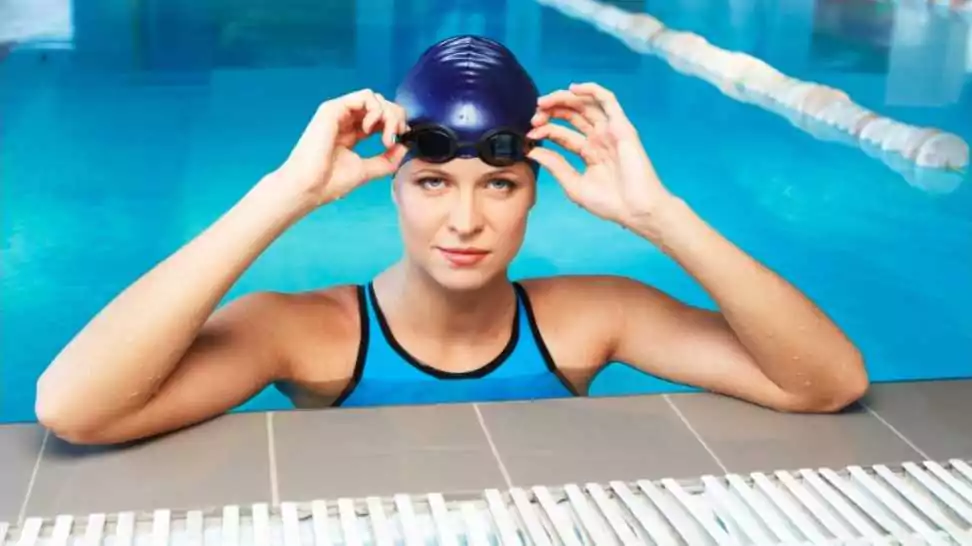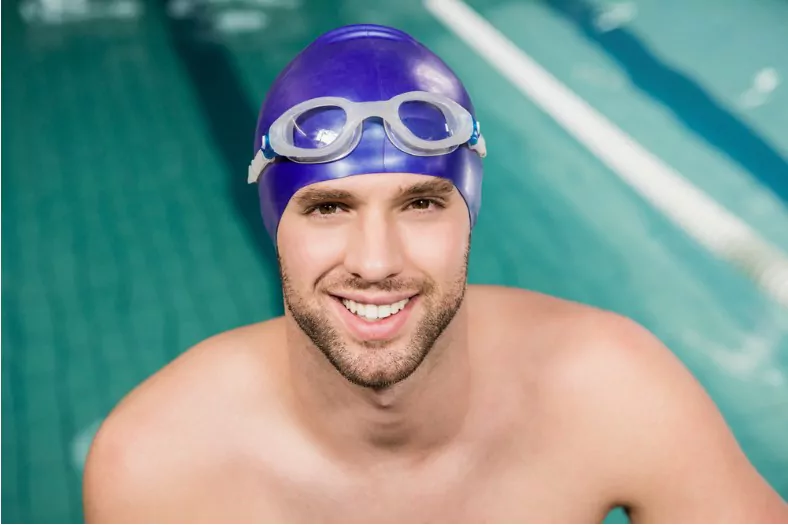How To Wear Swimming Cap? The Ultimate Guide

Swimming caps serve a crucial role in the aquatic world, transcending beyond mere accessories for swimmers. They are indispensable for both recreational and competitive swimmers, offering more than just an aesthetic appeal with their sleek designs and vibrant hues. These caps are essential for protecting hair from the harsh effects of chlorine and other pool chemicals, while also streamlining swimming to enhance performance.
This guide is crafted to demystify how to wear swimming cap perfectly, emphasizing the maintenance of dry hair—a significant concern for many in the swimming community. We delve into choosing the appropriate cap, provide detailed instructions for its correct application, and offer tips aimed at preserving hair dryness.
Our goal is to furnish you with the knowledge and practical advice necessary to improve your swimming routine. Whether you aim to safeguard your hair from damage or to refine your technique in wearing a swimming cap, this guide stands ready to elevate your water-based activities to new heights.
- Understanding the Purpose of a Swimming Cap
- Choosing the Right Swimming Cap
- Preparing to Wear Your Swimming Cap
- How to Wear a Swimming Cap Easily
- How to Wear a Swimming Cap for Men
- How to Wear a Swimming Cap Properly
- How to Wear a Swimming Cap to Keep Hair Dry
- How to Wear a Swimming Cap Without Wetting Hair
- Common Mistakes to Avoid
- Wrapping Up
1 Understanding the Purpose of a Swimming Cap

Swimming caps, often misunderstood and underestimated, are more than just a fashion statement or a mandatory requirement in public pools. They hold a significant place in the world of swimming, serving multiple essential purposes that go beyond the surface. In this section, we’ll explore the core reasons behind the use of swimming caps, dispel common misconceptions, and underline their importance for swimmers of all levels.
Hygiene
One of the primary reasons swimming caps are highly encouraged, if not mandatory, in most public swimming pools is hygiene. Caps help in minimizing the amount of hair that falls into the pool, reducing the risk of clogs in the filtration system and ensuring a cleaner swimming environment for everyone. This aspect of hygiene is critical in maintaining the operational efficiency of pool systems and providing a sanitary space for swimmers.
Efficiency
From a performance standpoint, swimming caps offer a significant advantage. By streamlining the head and reducing drag, caps allow swimmers to glide more smoothly through the water. This reduction in resistance can lead to improved swim times and a more efficient swimming experience. Competitive swimmers, in particular, can attest to the noticeable difference a well-fitted swimming cap makes in their performance.
Hair Protection
Chlorine and other chemicals found in swimming pools can have detrimental effects on hair health, leading to dryness, breakage, and discoloration. Swimming caps can mitigate these effects by providing a protective barrier between the pool water and the swimmer’s hair. While no cap can guarantee completely dry hair, especially for those with longer hairstyles, they significantly reduce the amount of water and chemicals that come into contact with the hair.
Dispelling Common Misconceptions
Complete Hair Dryness: A widespread misconception about swimming caps is that they are designed to keep hair completely dry. In reality, their primary purpose is to protect the hair from chlorine and reduce drag rather than waterproofing it. While silicone caps, in particular, are better at preventing water entry, some moisture may still seep in, especially around the edges.
One Size Fits All: Another fallacy is the belief that all swimming caps are created equal. Caps come in various materials, such as latex, silicone, and lycra, each with its own set of characteristics catering to different needs and preferences. The fit and comfort level can vary significantly between types and brands.
2 Choosing the Right Swimming Cap

Selecting the appropriate swimming cap is not a one-size-fits-all affair. The market offers a variety of cap types, each crafted from different materials with unique benefits. Understanding these differences is key to choosing a cap that not only fits well but also meets your specific swimming needs. Let’s delve into the main types of swimming caps available and provide some tips on selecting the right size and material.
Types of Swimming Caps
- Silicone Caps: Known for their durability and elasticity, silicone swimming caps are a popular choice among both recreational and competitive swimmers. They are thicker than other types, offering excellent protection against chlorine and a snug fit that reduces drag. Silicone caps are also less likely to pull on hair, making them a preferred option for swimmers with longer locks. Their durability means they can withstand regular use without tearing or losing shape.
- Latex Caps: These caps are thinner and more lightweight than silicone counterparts, providing a tighter fit that can lead to increased speed in the water. Latex caps are also more breathable, making them a good choice for swimmers who find silicone caps too warm. However, they are less durable and more prone to tearing. Swimmers with latex allergies should avoid these caps.
- Fabric Caps: Made from materials such as nylon or lycra, fabric caps are the most comfortable and least constrictive. They are easy to put on and take off, making them ideal for casual swimming or water aerobics. While fabric caps do not provide the same level of water resistance as silicone or latex caps, they do offer adequate protection against sun and chlorine, making them suitable for outdoor swimming pools.
Tips for Selecting the Right Cap
- Consider Your Swimming Environment: The choice between silicone, latex, and fabric caps can depend on your swimming environment. Competitive swimmers or those frequently in chlorinated pools might prefer silicone for its durability and efficiency. For open-water swimmers, a bright silicone cap can provide visibility in addition to protection. Casual swimmers or those with latex allergies might lean towards fabric caps for comfort.
- Size Matters: A common mistake is choosing a cap that’s too tight or too loose. While most swimming caps are designed to fit a wide range of head sizes, some brands offer variations in size. It’s essential to find a cap that fits snugly without being too tight. A cap that’s too tight can cause discomfort or headaches, while a loose cap will not provide adequate protection or efficiency in the water.
- Test for Comfort and Fit: If possible, try on different caps before making a purchase. Ensure the cap covers your hair completely without leaving any gaps, especially if keeping your hair dry is a priority. The cap should sit comfortably above your eyebrows and cover your ears slightly, without pinching the skin.
3 Preparing to Wear Your Swimming Cap
Wearing a swimming cap correctly starts long before you actually put the cap on your head. Proper preparation can significantly improve the cap’s fit, ensure your hair is well protected, and even extend the cap’s lifespan. For swimmers with long hair, preparation is especially crucial to avoid tangles and ensure all hair fits comfortably under the cap. Let’s look at how to prepare both your hair and swimming cap for the best possible experience.

Preparing Your Hair
- Wet Your Hair: Before putting on your swimming cap, wet your hair with fresh water. Wet hair is more pliable and easier to manage under a cap than dry hair. This step also adds an extra layer of protection against chlorine by saturating your hair with clean water, so it absorbs less chlorinated water from the pool.
- Apply a Leave-In Conditioner: For added protection, consider applying a small amount of leave-in conditioner to your hair. The conditioner can help shield your hair from chlorine damage and make slipping the cap over your hair smoother. Ensure the product is evenly distributed, focusing on the ends where hair is most prone to damage.
Handling Long Hair
- Tying Up Long Hair: If you have long hair, tying it up can make wearing a swimming cap much simpler. A low bun or a twist at the back of your head is often the most effective style, as high buns or ponytails can create bumps that make cap fitting difficult. Ensure the bun or twist is secure but not too tight to avoid discomfort under the cap.
- Swim Caps for Long Hair: Some swimming caps are specifically designed to accommodate long hair. These caps have extra room at the back to comfortably fit and protect longer hair. If you find regular caps too tight or uncomfortable, a long hair swim cap might be a perfect choice. These caps provide the added benefit of reducing pressure on the head and hair, making them ideal for swimmers with sensitive scalps.
Preparing Your Swimming Cap
- Check for Damage: Before each use, inspect your swimming cap for any tears or degradation. A damaged cap is less effective at protecting your hair and can break further when stretched over your head.
- Stretch the Cap: Gently stretch the cap with your hands to prepare it for easier placement on your head. This is especially important for silicone and latex caps, which can be quite snug. Avoid overstretching, as this can damage the cap.
- Apply a Light Powder for Latex Caps: If you’re using a latex cap, consider dusting it lightly with talcum powder after drying it post-swim. This can prevent the cap from sticking to itself and make it easier to put on next time.

4 How to Wear a Swimming Cap Easily
Putting on a swimming cap doesn’t have to be a struggle. With the right technique, you can easily wear your cap, whether you’re preparing for a casual swim or a competitive meet. Follow these step-by-step instructions to ensure your cap is properly and comfortably in place, ready to protect your hair and improve your swim.
Step-by-Step Instructions
- Prepare Your Hair: As mentioned earlier, start by wetting your hair slightly. This makes it easier to manage and reduces the amount of air trapped under the cap. If you have long hair, tie it up in a low bun or twist to ensure it fits comfortably under the cap.
- Hold the Cap Open: With your hands inserted into the swimming cap, hold it open wide by spreading your fingers apart. If you’re using a silicone or latex cap, make sure you have a firm grip since these materials can be slippery when wet.
- Position the Cap: Tilt your head down slightly and position the front of the cap on your forehead first, just above your eyebrows. Make sure the inside of the cap is touching your skin and not your hair at this initial point of contact.
- Pull the Cap Over Your Head: While maintaining the position on your forehead, use your hands to stretch the cap over your head, moving towards the back. If you have long hair, ensure that all of it is gently tucked under the cap as you pull it down. For those with very short hair, this step will be simpler and quicker.
- Adjust the Cap: Once the cap covers your head, take a moment to adjust it. The cap should sit comfortably above your eyebrows and ears. For silicone and latex caps, you may need to smooth out any wrinkles or air pockets to ensure a snug fit. Be gentle to avoid tearing the cap, especially if it’s made of latex.
- Secure the Cap Over Your Ears: Although some swimmers prefer to wear their cap over their ears to block water, others find it more comfortable to tuck their ears out slightly. Experiment with both methods to see which feels best for you. If you’re aiming for speed and efficiency, covering your ears can help reduce drag.
Tips for Comfort and Efficiency
- Use Both Hands: Always use both hands to put on your cap. This ensures an even stretch and reduces the risk of tearing.
- Be Gentle: Especially with latex caps, being too forceful can cause tears. Silicone caps are more durable but can still be damaged with rough handling.
- Practice Makes Perfect: If you’re new to wearing swimming caps, practice putting it on a few times before you need to do it quickly, such as before a swim meet.
5 How to Wear a Swimming Cap for Men

For men, particularly those with short hair or bald heads, wearing a swimming cap might seem unnecessary at first glance. However, the benefits—ranging from hygiene in the pool to reduced drag while swimming—apply equally, regardless of hair length. Here’s how men can ensure a secure and comfortable fit when wearing a swimming cap, along with tips to address common concerns such as cap tightness and forehead pressure.
Tips for a Secure and Comfortable Fit
- Choosing the Right Cap: Men with short hair or those who are bald might prefer silicone caps for their durability and comfort. Silicone caps tend not to pull on hair or skin, making them a good choice for minimizing discomfort. They also provide a snug fit that can help keep the cap in place without excessive tightness.
- Prepping the Head: Even if you have very short hair or no hair, rinsing your head with water before putting on the cap can be beneficial. This can help the cap slide on more easily and improve its grip on your skin, reducing the chance of it slipping off during your swim.
- Applying the Cap: When putting on the cap, start by placing your hands inside it and spreading it open. Position the front edge of the cap on your forehead just above your eyebrows and then pull the cap over your head towards the back. For those with short hair, ensure any hair is covered. If you are bald, check that the cap sits evenly across your head without bunching up.
- Adjusting for Comfort: Once the cap is on, you may need to adjust it to alleviate any pressure points or tightness, especially around the forehead and ears. If the cap feels too tight, try stretching it gently but firmly for a better fit. For silicone caps, a slight adjustment in positioning can also relieve tightness without compromising the cap’s effectiveness.
- Addressing Forehead Pressure: If you experience discomfort or pressure on your forehead, ensure that the cap is not too low on your brow. Repositioning it slightly higher can relieve pressure without risking water entry. Some swimmers find that applying a thin layer of petroleum jelly on pressure points before wearing the cap can also increase comfort.
Common Concerns for Men
- Cap Tightness: It’s important for the cap to be snug to prevent water from entering and to reduce drag. However, if the cap is uncomfortably tight, consider trying a larger size or a different material that stretches more easily. Remember, a proper fit should feel secure but not cause discomfort or headaches.
- Slippage for Bald Swimmers: Men without hair might worry about the cap slipping off. Choosing a cap with a textured interior can help prevent slippage. Additionally, ensuring the cap is dry on the outside before diving in can improve grip with the water.
- Ear Coverage: Men with or without hair should decide on ear coverage based on comfort and personal preference. Covering the ears can enhance streamline but might feel uncomfortable for some. Experiment with both styles to find your preference.
6 How to Wear a Swimming Cap Properly
Wearing a swimming cap correctly is essential not only for protecting your hair from chlorine and keeping it out of your face but also for minimizing water resistance and drag. A properly fitted cap can enhance your swimming performance and comfort. Here are detailed instructions and tips to ensure your swimming cap is worn correctly, covering how to adjust the cap for optimal fit and performance.
Ensuring a Proper Fit
- Start at the Forehead: After preparing and positioning the cap as previously described, ensure it sits just above the eyebrows on your forehead. This starting point helps in achieving a streamlined fit that covers the entire hairline and reduces drag.
- Smooth Out Air Pockets: Once the cap is on, gently press down on the top and sides of the cap to eliminate any air pockets. Air pockets can increase drag and make the cap more likely to come off during swimming. Be gentle to avoid ripping the cap, especially if it’s made of latex.
- Adjust for Ear Coverage: Decide whether you want your ears covered or not. Covering your ears can reduce noise and further decrease drag, but some swimmers find it uncomfortable or prefer to leave their ears out for better hearing. If you choose to cover your ears, ensure the cap is stretched out enough to comfortably encompass them without causing pressure or discomfort.
- Check the Back: The back of the cap should cover all your hair and touch the nape of your neck. If you have long hair tied up, make sure the bun or ponytail is completely enclosed within the cap. This helps prevent water from getting into the cap and ensures a sleek profile.
- Final Adjustments: Once the cap is fully on, do a final check around the edges. The cap should fit snugly against your head without any lifted edges or loose areas. If you have a silicone cap, you might be able to slide your fingers under the edge and gently pull it down for a closer fit around your hairline and ears.
Tips for Comfort and Performance
- Use a Mirror: The first few times you put on your swimming cap, it might be helpful to use a mirror. This way, you can see all angles and ensure there are no folds or misalignments that could cause drag.
- Practice Adjusting: Getting the perfect fit may require some practice. Don’t hesitate to take off the cap and start again if it doesn’t feel right. Comfort is key to ensuring you can focus on your swimming.
- Be Mindful of Pressure: While a snug fit is necessary to prevent water entry and reduce drag, the cap should not be so tight that it causes headaches or discomfort. If you experience any pain or excessive pressure, the cap may be too small, or you might need to adjust how you’re wearing it.
- Consider Cap Material: Remember that different materials will fit differently. Silicone caps are more forgiving and easier to adjust without tearing. Latex caps offer a tighter fit but require more careful handling. Fabric caps are the most comfortable and easiest to adjust but provide the least protection against water.
7 How to Wear a Swimming Cap to Keep Hair Dry
While no swimming cap can guarantee 100% dry hair—especially during rigorous swimming or complete submersion—certain techniques and choices can significantly minimize water entry. For swimmers who prioritize keeping their hair as dry as possible, understanding how to optimize the fit of a swimming cap and selecting the right materials are crucial steps. Let’s explore some effective strategies, including the practice of double capping and the best materials for dry hair.
Techniques for Minimizing Water Entry
- Tight Seal Around the Edges: Ensuring a tight seal around the edges of the cap is vital. Start by placing the cap on your forehead just above the eyebrows and then stretch it down over the back of your head. This method helps create a seal that reduces water entry. Pay special attention to the area around your ears and the nape of your neck, as these are common places where water can seep in.
- Hair Preparation: For those with long hair, tying your hair up in a bun or twist at the crown of your head can help create a smoother surface for the cap. This reduces bumps and gaps where water might enter. Wetting your hair before putting on the cap can also help, as it lays your hair flat and prevents air pockets within the cap.
- Double Capping: A popular technique among competitive swimmers is double capping, where a thinner latex or silicone cap is worn over a thicker silicone cap. The first cap helps to smooth the hair and create a tight seal, while the second cap adds an extra layer of protection against water. To double cap, first put on a tighter latex cap to compress your hair against your head, then layer a silicone cap on top for a snug fit and added water resistance.
Cap Materials Best Suited for Dry Hair
- Silicone Caps: Silicone caps are thicker and less permeable than their latex counterparts, making them a superior choice for keeping hair dry. They are also more durable and less likely to tear, providing a better seal over time. However, completely dry hair is difficult to achieve, especially during long or vigorous swimming sessions.
- Latex Caps: While thinner and more flexible, latex caps can still offer a decent level of protection against water if fitted correctly. They conform closely to the shape of the head, which can help in creating a seal. However, they are more prone to tearing and may not be as effective as silicone caps in keeping hair dry.
- Neoprene Caps: Often used in open water swimming and triathlons, neoprene caps provide excellent insulation and water resistance. They are thicker than silicone and latex caps and can offer a better barrier against water. Neoprene caps are especially suited for swimmers in colder environments but might be too warm for indoor pools.
Additional Tips
- Check for Gaps: After putting on your cap(s), check for any gaps or loose areas around the edges. Adjust as necessary to ensure a snug fit all around.
- Cap Size and Fit: Ensure that your swimming cap fits well. A cap that’s too tight may not cover your head completely, while a cap that’s too loose won’t provide an effective seal against water.
- Use a Waterproof Product: Some swimmers apply a waterproof product around the hairline before putting on a swimming cap. Products like petroleum jelly can provide an additional barrier to water entry, though this method is more about minimizing water ingress than ensuring complete dryness.

8 How to Wear a Swimming Cap Without Wetting Hair
While completely preventing your hair from getting wet while swimming is a challenging task, certain strategies and products can significantly reduce water exposure. These methods focus on cap placement, waterproofing techniques, and the use of specific accessories designed to keep your hair as dry as possible under a swimming cap. Here are some additional strategies and product recommendations.
Strategies for Cap Placement and Waterproofing
- Proper Cap Placement: Achieving a secure and snug fit is crucial. Start by placing the cap on your forehead, just above your eyebrows, and then stretch it over the back of your head, ensuring it covers your entire hairline. A well-placed cap minimizes the chances of water seeping in.
- Silicone Caps for a Better Seal: Silicone swimming caps are thicker and provide a tighter seal compared to latex or fabric caps. Opting for a high-quality silicone cap can make a difference in how well it prevents water from reaching your hair.
- Waterproof Barrier Products: Before wearing your cap, consider applying a thin layer of a waterproof barrier product around the edges of your hairline. Petroleum jelly or silicone-based products can act as an additional seal between your cap and skin, reducing water ingress.
Products and Accessories for Keeping Hair Dry
- Swim Caps Designed for Dry Hair: Some swim caps are specifically marketed as being more effective at keeping hair dry. These caps often have extra sealing features, such as tighter bands around the base or double-layered designs, to help prevent water entry.
- Swim Cap with an Inner Seal: Look for caps that have an inner silicone or rubber seal. These are designed to grip the skin more effectively around the edges, providing an additional barrier to water.
- Hair Guards: Hair guards, or swim bands, worn underneath a swimming cap, can offer an extra layer of protection. They are designed to cover the hairline and ears closely, reducing the amount of water that can seep underneath the cap.
- Ear Plugs and Nose Clips: While their primary purpose is not to keep hair dry, using ear plugs and nose clips can reduce the overall amount of water that splashes onto your face and head, indirectly helping to keep your hair dry.
9 Common Mistakes to Avoid
Wearing a swimming cap may seem straightforward, but several common mistakes can lead to discomfort, decreased cap effectiveness, and even damage to the cap or your hair. Recognizing and avoiding these pitfalls can enhance your swimming experience. Here’s a list of common mistakes to watch out for, along with tips on how to avoid them. Emphasizing patience and practice is key to mastering the art of cap-wearing.
Common Mistakes and How to Avoid Them
- Using a cap that’s too tight can cause headaches and discomfort, while a cap that’s too loose won’t effectively keep water out or reduce drag. Similarly, selecting the wrong material can affect comfort and durability. Measure your head and consult size charts before purchasing. Consider your needs (e.g., water temperature, hair protection) when selecting cap materials.
- Placing the cap too low can restrict vision and cause discomfort. Position the cap just above your eyebrows to ensure a snug fit without impairing your sight.
- Dry hair can create friction, making the cap harder to put on and increasing the risk of tearing, especially with latex caps. Lightly wet your hair before wearing the cap to reduce friction and make the process smoother.
- Air pockets can increase drag and make the cap more likely to come off during swimming. Once the cap is on, gently press down to remove any trapped air, ensuring a snug fit.
- Puling the cap down forcefully can lead to tears, especially in latex caps, or can cause discomfort by pulling on the hair. Gently stretch the cap over your head, being careful not to pull too hard.
- Neglecting to properly rinse, dry, and store your swimming cap can lead to material degradation, especially for latex and silicone caps. Rinse your cap in fresh water after use, let it air dry away from direct sunlight, and sprinkle it with talcum powder if it’s made of latex to prevent sticking.
- Especially for beginners, putting on a swimming cap can be tricky and may not always go smoothly on the first try. Practice putting on and taking off your cap at home to become more comfortable with the process. This can also help you identify the best method for your hair type and cap material.
10 Wrapping Up
Swimming is a journey, and the right gear can make all the difference. By experimenting with and refining your swimming cap techniques, you’re not just protecting your hair—you’re enhancing your entire swimming experience. Share your stories and tips, and let’s continue to learn from each other in pursuit of our swimming goals.
Community Q&A
About This Article
This article has been viewed 142 times.




Over the last week I eagerly started following this phenomenal website, they share fabulous content with visitors. The site owner excels at educating customers. I’m excited and hope they keep up their awesome work!